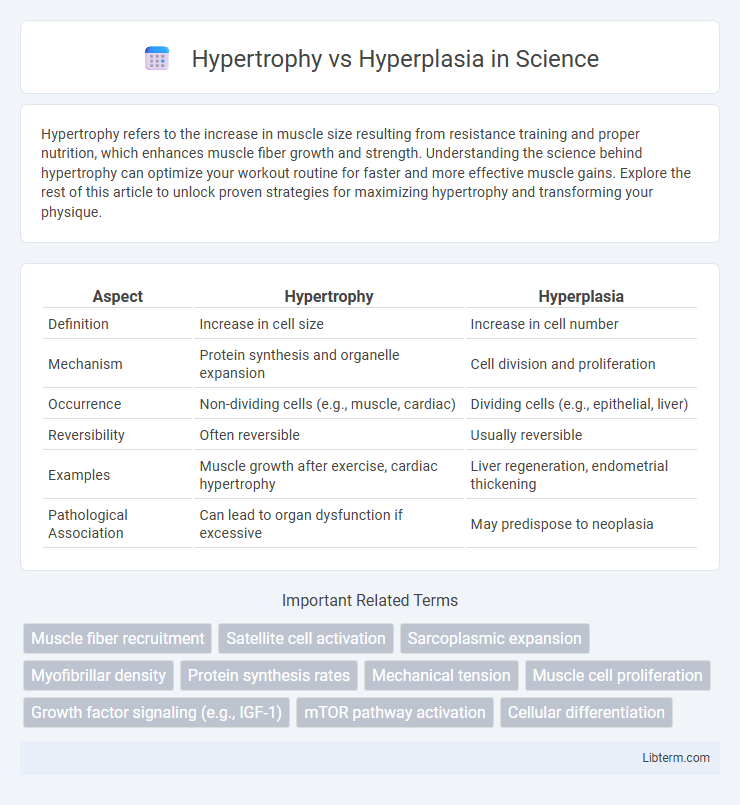Hypertrophy refers to the increase in muscle size resulting from resistance training and proper nutrition, which enhances muscle fiber growth and strength. Understanding the science behind hypertrophy can optimize your workout routine for faster and more effective muscle gains. Explore the rest of this article to unlock proven strategies for maximizing hypertrophy and transforming your physique.
Table of Comparison
| Aspect | Hypertrophy | Hyperplasia |
|---|---|---|
| Definition | Increase in cell size | Increase in cell number |
| Mechanism | Protein synthesis and organelle expansion | Cell division and proliferation |
| Occurrence | Non-dividing cells (e.g., muscle, cardiac) | Dividing cells (e.g., epithelial, liver) |
| Reversibility | Often reversible | Usually reversible |
| Examples | Muscle growth after exercise, cardiac hypertrophy | Liver regeneration, endometrial thickening |
| Pathological Association | Can lead to organ dysfunction if excessive | May predispose to neoplasia |
Understanding Hypertrophy and Hyperplasia
Hypertrophy refers to the increase in cell size, leading to the enlargement of a tissue or organ without an increase in cell number, commonly observed in muscle growth due to resistance training. Hyperplasia involves an increase in the number of cells within a tissue or organ, often seen in hormonal responses such as endometrial proliferation during the menstrual cycle. Both processes contribute to tissue growth but differ fundamentally in their cellular mechanisms, impacting how the body adapts to physiological demands.
Definitions: What Is Hypertrophy?
Hypertrophy is defined as the increase in the size of individual cells, leading to the enlargement of a tissue or organ without an increase in the number of cells. This cellular growth results from enhanced protein synthesis and organelle expansion, commonly seen in muscle tissue after resistance training. Unlike hyperplasia, which involves an increase in cell number, hypertrophy directly impacts the volume and functional capacity of existing cells.
Definitions: What Is Hyperplasia?
Hyperplasia refers to the increase in the number of cells within a tissue or organ, resulting in its enlargement. This cellular proliferation differentiates hyperplasia from hypertrophy, which involves an increase in the size of existing cells rather than cell number. Hyperplasia plays a crucial role in tissue growth, repair, and certain pathological conditions, making it a fundamental concept in cell biology and medicine.
Cellular Mechanisms of Muscle Growth
Hypertrophy involves an increase in muscle fiber size through enhanced protein synthesis and satellite cell activation, leading to enlarged myofibrils within existing muscle cells. Hyperplasia refers to an increase in muscle fiber number, possibly through satellite cell proliferation and differentiation, although its occurrence in human skeletal muscle remains controversial. Both mechanisms contribute to muscle growth but hypertrophy is the predominant adaptation in response to resistance training at the cellular level.
Hypertrophy: How Muscles Get Bigger
Hypertrophy refers to the increase in muscle size primarily through the enlargement of individual muscle fibers due to protein synthesis and enhanced contractile elements. Resistance training triggers hypertrophic growth by stimulating muscle cells to accumulate more actin and myosin filaments, increasing the cross-sectional area of muscle fibers. Unlike hyperplasia, which involves the formation of new muscle cells, hypertrophy is the dominant mechanism underlying muscle growth in response to strength training and mechanical overload.
Hyperplasia: Can We Increase Muscle Cell Number?
Hyperplasia refers to the increase in muscle cell number, distinct from hypertrophy, which is the enlargement of existing muscle fibers. Scientific evidence on hyperplasia in human skeletal muscle remains limited, but animal studies suggest it may occur under specific conditions like heavy resistance training and muscle damage. Understanding hyperplasia's mechanisms could revolutionize muscle growth strategies by promoting new muscle fiber formation alongside hypertrophy.
Differences Between Hypertrophy and Hyperplasia
Hypertrophy refers to the increase in cell size leading to the enlargement of a tissue or organ, while hyperplasia involves an increase in the number of cells within a tissue. Hypertrophy occurs without cell division, commonly seen in muscle growth due to exercise, whereas hyperplasia results from cell proliferation, such as in the regeneration of liver tissue. These processes differ fundamentally in cellular mechanisms and contribute distinctly to tissue growth and adaptation.
Factors Influencing Muscle Hypertrophy
Muscle hypertrophy is primarily influenced by mechanical tension, metabolic stress, and muscle damage, which stimulate muscle fiber growth through increased protein synthesis. Nutritional factors like adequate protein intake and hormonal responses involving testosterone, growth hormone, and insulin-like growth factor 1 (IGF-1) also play crucial roles. Training variables such as resistance load, volume, frequency, and progressive overload significantly impact the extent of hypertrophic adaptation.
Can Hyperplasia Occur in Humans?
Hyperplasia can occur in humans and involves an increase in the number of cells within a tissue or organ, contributing to tissue growth. Unlike hypertrophy, which is the enlargement of existing cells, hyperplasia results from enhanced cellular proliferation stimulated by various physiological or pathological factors. Common examples include the proliferation of glandular cells in the breast during puberty and pregnancy or the regeneration of the liver following partial hepatectomy.
Practical Implications for Training and Muscle Gain
Hypertrophy involves the increase in muscle fiber size primarily through resistance training and progressive overload, resulting in enhanced muscle strength and volume. Hyperplasia, the increase in muscle fiber number, remains less understood and less commonly observed in humans, limiting its direct application in standard training programs. Practical training strategies should focus on maximizing hypertrophy through varied resistance exercises, nutrition, and recovery to optimize muscle gain effectively.
Hypertrophy Infographic

 libterm.com
libterm.com